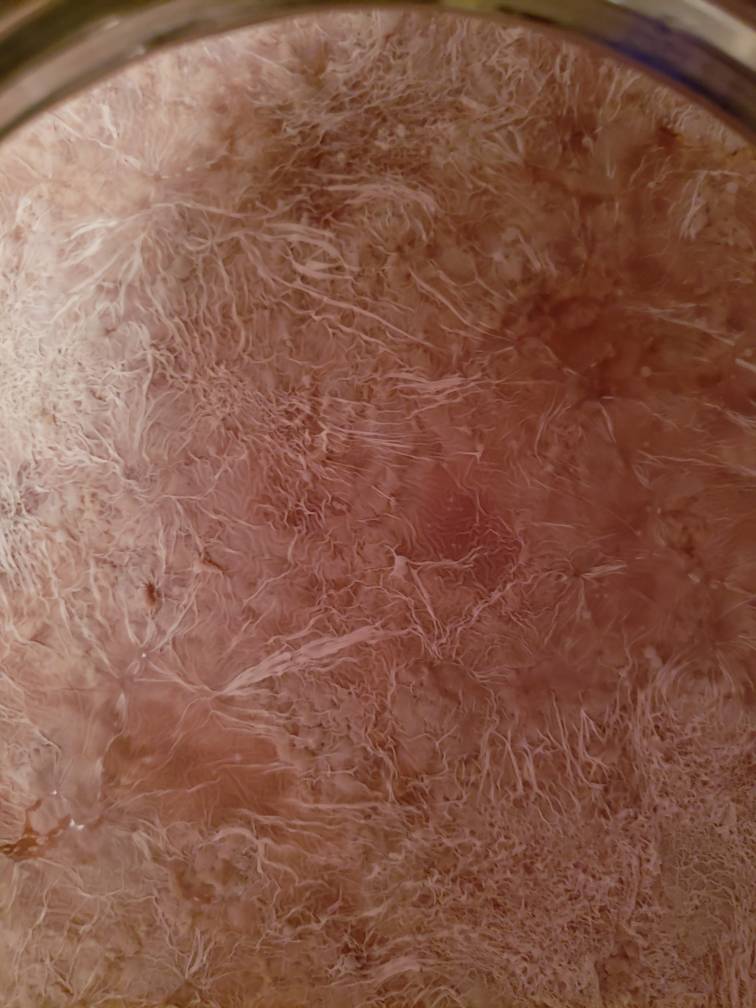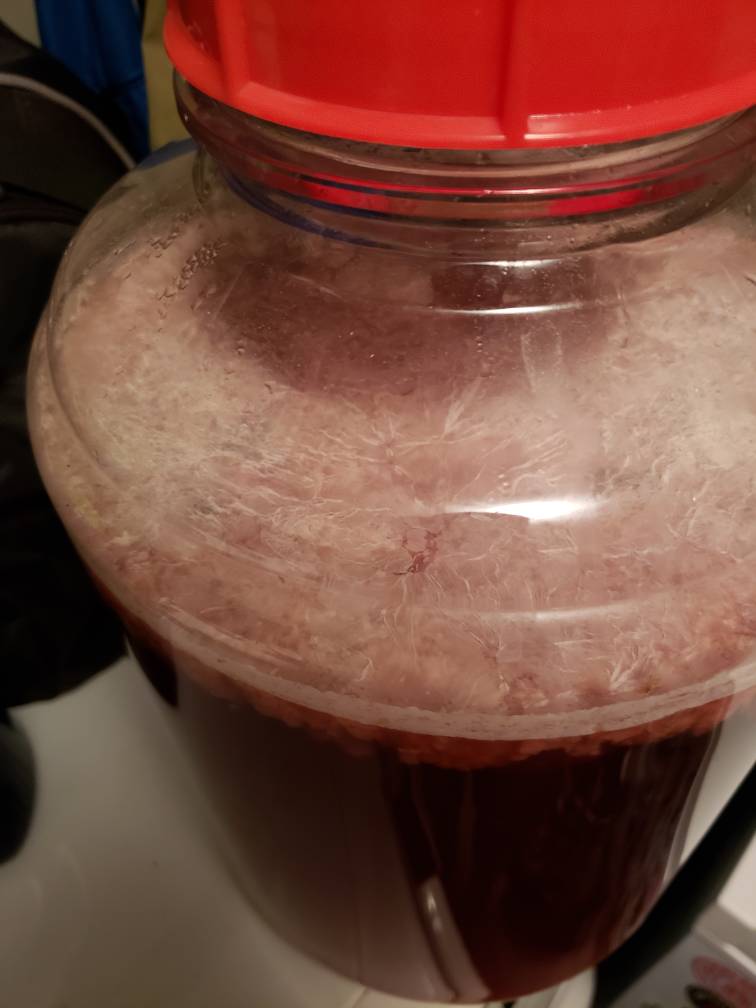You are using an out of date browser. It may not display this or other websites correctly.
You should upgrade or use an alternative browser.
You should upgrade or use an alternative browser.
Raspberry Sour Infection?
- Thread starter Matt_man
- Start date

Help Support Homebrew Talk:
This site may earn a commission from merchant affiliate
links, including eBay, Amazon, and others.
Andrew Hodgson
Well-Known Member
Yes that definitely looks infected to me.
Hard to tell. Raspberries dont need much time in a beer to extract flavor. They turn white and float when done, usually just a few days. I have a MTF reverse sour with raspberries on tap right now. I think I racked off the fruit after a week, but could have done it 2 or 3 days sooner.
Like any sour or any beer really, you want to limit headspace as much as possible.
Like any sour or any beer really, you want to limit headspace as much as possible.
My guess would be mold if there is an issue, but I can tell. Is that picture through the glass? If so, I dont think it's an infection, but rather just raspberries pressed against the glass.
5 days seems like a very short time period for a bad mold to appear.
5 days seems like a very short time period for a bad mold to appear.
Also, did you boil after souring, or did you move ahead with pitching yeast? If you didn't boil, I would lean towards that being a pellicle.

$58.16
HUIZHUGS Brewing Equipment Keg Ball Lock Faucet 30cm Reinforced Silicone Hose Secondary Fermentation Homebrew Kegging Brewing Equipment
xiangshuizhenzhanglingfengshop

$33.95
Five Star - 6022b_ - Star San - 32 Ounce - High Foaming Sanitizer
Bridgeview Beer and Wine Supply

$39.22 ($39.22 / Count)
Brewer's Best Home Brew Beer Ingredient Kit - 5 Gallon (Mexican Cerveza)
Amazon.com

$20.94
$29.99
The Brew Your Own Big Book of Clone Recipes: Featuring 300 Homebrew Recipes from Your Favorite Breweries
Amazon.com

$22.00 ($623.23 / Ounce)
AMZLMPKNTW Ball Lock Sample Faucet 30cm Reinforced Silicone Hose Secondary Fermentation Homebrew Kegging joyful
无为中南商贸有限公司

$10.99 ($31.16 / Ounce)
Hornindal Kveik Yeast for Homebrewing - Mead, Cider, Wine, Beer - 10g Packet - Saccharomyces Cerevisiae - Sold by Shadowhive.com
Shadowhive

$7.79 ($7.79 / Count)
Craft A Brew - LalBrew Voss™ - Kveik Ale Yeast - For Craft Lagers - Ingredients for Home Brewing - Beer Making Supplies - (1 Pack)
Craft a Brew

$27.29 ($13.64 / Count)
$41.99 ($21.00 / Count)
2 Pack 1 Gallon Large Fermentation Jars with 3 Airlocks and 2 SCREW Lids(100% Airtight Heavy Duty Lid w Silicone) - Wide Mouth Glass Jars w Scale Mark - Pickle Jars for Sauerkraut, Sourdough Starter
Qianfenie Direct

$176.97
1pc Commercial Keg Manifold 2" Tri Clamp,Ball Lock Tapping Head,Pressure Gauge/Adjustable PRV for Kegging,Fermentation Control
hanhanbaihuoxiaoshoudian

$53.24
1pc Hose Barb/MFL 1.5" Tri Clamp to Ball Lock Post Liquid Gas Homebrew Kegging Fermentation Parts Brewer Hardware SUS304(Liquid Hose Barb)
Guangshui Weilu You Trading Co., Ltd
![Craft A Brew - Safale S-04 Dry Yeast - Fermentis - English Ale Dry Yeast - For English and American Ales and Hard Apple Ciders - Ingredients for Home Brewing - Beer Making Supplies - [1 Pack]](https://m.media-amazon.com/images/I/41fVGNh6JfL._SL500_.jpg)
$6.95 ($17.38 / Ounce)
$7.47 ($18.68 / Ounce)
Craft A Brew - Safale S-04 Dry Yeast - Fermentis - English Ale Dry Yeast - For English and American Ales and Hard Apple Ciders - Ingredients for Home Brewing - Beer Making Supplies - [1 Pack]
Hobby Homebrew

$53.24
1pc Hose Barb/MFL 1.5" Tri Clamp to Ball Lock Post Liquid Gas Homebrew Kegging Fermentation Parts Brewer Hardware SUS304(Liquid Hose Barb)
yunchengshiyanhuqucuichendianzishangwuyouxiangongsi
bigdawg86
Well-Known Member
- Joined
- May 1, 2017
- Messages
- 468
- Reaction score
- 197
That looks like a pellicle. I wouldn't worry about it. 5 days isn't enough to get real off flavors like acetic acid... it will likely taste great. I just did a raspberry saison in July and it turned out great, raspberries do have a little sour bite after taste though. Just rack the beer and bottle / keg as normal. If you choose to bottle, I would store cold once fully carbonated to avoid bottle bombs.
RPh_Guy
Bringing Sour Back
That is a pellicle, indicating wild yeast or bacteria.
It doesn't look like mold to me. The film areas aren't fuzzy, correct?
Personally I would monitor specific gravity for 3-4 weeks to make sure it's stable before bottling, because I prefer to be more cautious. Then I would closely monitor carbonation level to be sure it doesn't overcarbonate. If you can, refrigerate after carbonation is finished (to slow down the wild microbes from developing flavor or carbonation).
Most people keep separate plastic equipment for wild yeast & bacteria to avoid added risk of infecting future batches. Plastic is prone to holding microbial contaminants and biofilms.
Use PBW or similar to soak it. Plastic shouldn't be scrubbed.
FYI: Either heat pasteurization of additives or pureeing & sulfiting them 24 hours beforehand is the only way to avoid contaminating a clean beer.
Cheers, good luck.
It doesn't look like mold to me. The film areas aren't fuzzy, correct?
Personally I would monitor specific gravity for 3-4 weeks to make sure it's stable before bottling, because I prefer to be more cautious. Then I would closely monitor carbonation level to be sure it doesn't overcarbonate. If you can, refrigerate after carbonation is finished (to slow down the wild microbes from developing flavor or carbonation).
Most people keep separate plastic equipment for wild yeast & bacteria to avoid added risk of infecting future batches. Plastic is prone to holding microbial contaminants and biofilms.
Use PBW or similar to soak it. Plastic shouldn't be scrubbed.
FYI: Either heat pasteurization of additives or pureeing & sulfiting them 24 hours beforehand is the only way to avoid contaminating a clean beer.
Cheers, good luck.
Matt_man
Active Member
- Joined
- Sep 19, 2014
- Messages
- 34
- Reaction score
- 2
Thanks for the input everyone! I'm pretty sure it's not mold as I don't see any fuzzy edges. The last picture was taken through the top looking down. I boiled after I soured. It was sitting at 65 the entire time until I had to take it out of the freezer to cold crash another beer. Here is the latest progress. First one is from the top and second is from the side. I'm debating on if I should just pull it out now and throw it into bottles. Just worried that it might infect my bottling equipment. Or should I just let it ride for a while?




Those pics definitely show bugs having a party...
Definitely a pellicle. Curious - did you freeze your fruit first?
Also, for future reference, you really need to minimize headspace more in secondary. As little air as possible.
RPh_Guy
Bringing Sour Back
The organism(s) cannot be identified by the pellicle.Looks like bacillus by the morphology
http://www.milkthefunk.com/wiki/Pellicle
Yes you can. I had this conversation with a FDA auditor once. She claimed in our lab we couldn't visually identify to genus environmental isolates based on colony morphy.
Subsequently our formal response was to submit study data comparing visual presumptive IDs performed by the analyst to ID to species using PCR. We had over 90% accuracy to genus we could even do some colonies reliably to species.
Colonies are essentially the same as a pellicle, it's just the media that is different.
My 17 years as a microbiologist makes me think that's a bacillus. It might not be, but it does have very typical bacillus morphology. Dry, crenulated, irregular edges.
Subsequently our formal response was to submit study data comparing visual presumptive IDs performed by the analyst to ID to species using PCR. We had over 90% accuracy to genus we could even do some colonies reliably to species.
Colonies are essentially the same as a pellicle, it's just the media that is different.
My 17 years as a microbiologist makes me think that's a bacillus. It might not be, but it does have very typical bacillus morphology. Dry, crenulated, irregular edges.
Matt_man
Active Member
- Joined
- Sep 19, 2014
- Messages
- 34
- Reaction score
- 2
The raspberries were bought frozen from the store. Added to primary after two weeks of fermentation. No secondary. This was just supposed to be quick and easy haha.
So do we think it's just a bacillus like Lactobacillus that I can just let ride for a while?
So do we think it's just a bacillus like Lactobacillus that I can just let ride for a while?
RPh_Guy
Bringing Sour Back
Bacillus is not Lactobacillus.
Even if it is Bacillus forming the pellicle, that doesn't exclude the likelihood that it's a poly-microbial contamination from the non-sanitized fruit.
My recommendations are posted above
Even if it is Bacillus forming the pellicle, that doesn't exclude the likelihood that it's a poly-microbial contamination from the non-sanitized fruit.
My recommendations are posted above
Unfortunately it's a persistent fallacy in the microbiology community which relays on the fact that colony morphology changes with nutrient and incubation conditions.I trust the MTF statement. The wiki is very well researched.
If you have more accurate info, it'd be awesome if you would contribute there.
However that dosn't mean that in most instances you can't tell, there will be occasions when you get it wrong but more times than not you will be right, especially if you are familiar with morphologies present in you local biota.
Also key things to note here is there is a big difference between some genus morphologies than others. I wouldn't want to make a call on the pellicle of different gram positive cocci but bacillus is as distinctive as mold.
I think if mold was growing on top or even in suspension everyone would be able to tell. It very distinctive. Though technicslly not a pellicle.
Similar threads
- Replies
- 16
- Views
- 2K
Latest posts
-
-
-
Factors affecting Water Chemistry Calculations (Oh no, not again!)
- Latest: Unicorn_Platypus
-
-
-













































